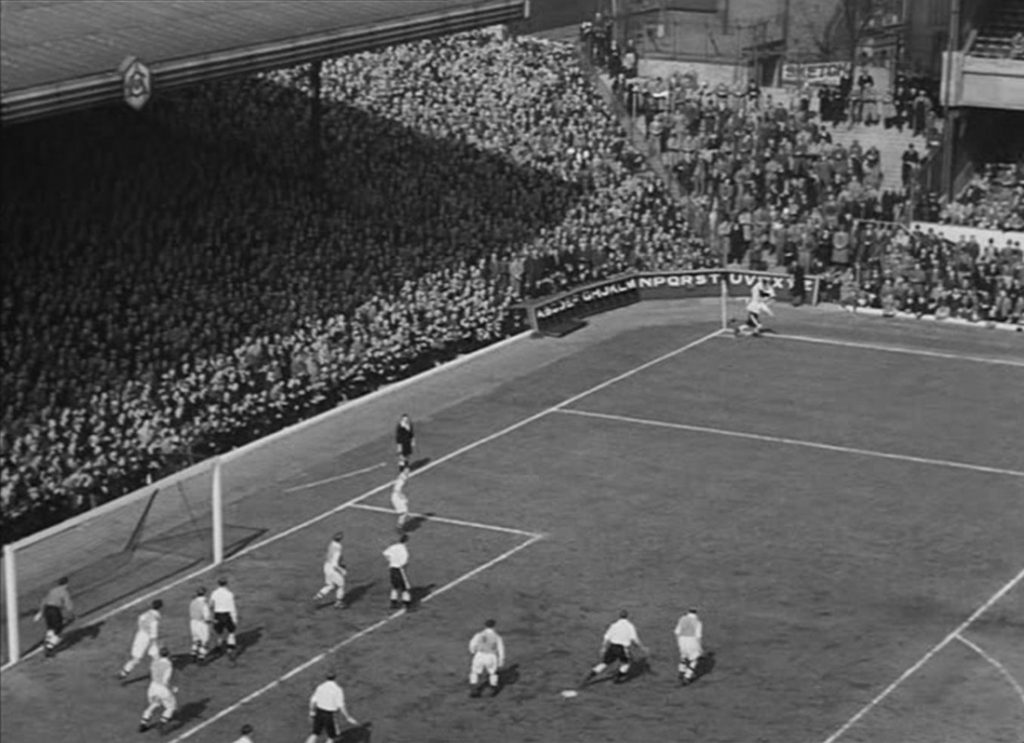London Between the Wars: The Football League on Film
London was an obvious location for the UK’s fledgling film industry, with many early-twentieth century pictures shot in and around the capital. As cinema’s popularity grew in tandem with professional football between the Wars, a number of films naturally made use of London’s football grounds.

One of the first of these was The Winning Goal (1920), directed by G. B. Samuelson, with match sequences filmed at Brentford’s Griffin Park – the West London club had entered the Football League that year. As Stephen Glynn recounts, the football scenes benefitted from the company hiring “22 first-division professional players, all of whom had just resumed their football career after war service. These included seven of the 1919-20 season’s title-winning West Bromwich Albion, notably the division’s top scorer (with 37 goals) Fred Morris, plus fellow-England internationals outside-right Dicky Bond, Derby County forward Alf Quantrill, and Bolton’s Wales outside-left Ted Vizard.”
The main stars of The Winning Goal were the Chelsea and England international Jack Cock, and former Arsenal and Bradford City centre-forward Harold Walden, top scorer as Great Britain won Olympic gold in 1912. Both players combined their football exploits with appearances on the music hall circuit, and were ideally suited to dramatic performance. The film was well received, with Bioscope magazine noting “The production and photography are good and the public should welcome this story of a popular sport, which has rarely been treated on the screen”.

Jack Cock of Chelsea and England 
Harold Walden – footballer, actor and music hall performer
Cock also appeared in the next major football film, 1930’s The Great Game, “the first surviving full-length football feature”. The Great Game capitalised on football’s popularity and technical advances in cinema to incorporate pioneering location footage – it included scenes shot at Wembley during the 1930 FA Cup Final between two of the great sides of the day, Arsenal and Huddersfield Town. Again “two specially recruited teams of professionals” performed the match sequences, filmed at Chelsea’s Stamford Bridge. The plot revolved around an ambitious chairman clashing with his manager while their team (Stockford United) win the FA Cup. According to Glynn, “Bioscope lauded one of the best football films which has yet come out”. Director Jack Raymond followed up with a film the following year about a northern football fan in London for the FA Cup Final, Up for the Cup. When The Great Game was re-made in 1953, its main football location was shifted to Griffin Park, home of Brentford.
The football action in The Lucky Number (1933) revolved around Arsenal, then Football League Champions under Herbert Chapman and the dominant club of the decade. As Woolwich Arsenal, they had become the first London club to join the Football League in 1893, before moving across the city from Plumstead to a North London site owned by St. John’s College of Divinity in 1913, where their Highbury ground was laid out by Archibald Leitch. Directed by Anthony Asquith, the film follows Rovers player Percy Gibbs (Clifford Mollison) as he tries to retrieve a winning lottery ticket. Shot in and around Highbury, ‘members of the Arsenal Football Club’ are credited, with physio-trainer Tom Whittaker, England left-back Eddie Hapgood, star winger Cliff Bastin and Welsh international Bob John all featuring. The inter-cut match footage was filmed during a First Division fixture between Arsenal and Bolton in October 1931. The Lucky Number was praised in Film Weekly for its “admirable use of typically British scenes and settings”. Arsenal and Highbury were soon to be filmed again.

The Great Game, 1930 film 
The Lucky Number, 1933 film
What is now regarded as the most successful pre-War football film, The Arsenal Stadium Mystery, was made shortly after Highbury’s art deco overhaul by architects Claude Ferrier and William Binnie. Based on Leonard Gribble’s crime novel – he later wrote They Kidnapped Stanley Matthews – director Thorold Dickinson made full use of the famous marble halls and corridors of the spectacular East Stand, opened in 1936. Described in the club’s matchday programme as a ‘building of wonder’, the stand included canteens, tearooms, covered toilets, and “access to a huge Horse Shoe Bar, purported to be one of the largest in the world.” Such facilities, never before seen in English football, led contemporary newspapers to declare that the East Stand “embraced the latest ideas in luxury and comfort”. Much of the film’s action takes place in the dressing-rooms which, with under-floor heating, “left nothing to be desired”, and the treatment room boasting “the very latest electrical apparatus”.

Once again, actual match footage (of Arsenal v Brentford in May 1939, the last Highbury fixture before the Second World War) was interspersed with staged scenes featuring several members of the Gunners’ 1938 title-winning squad, Whittaker and manager George Allison. The fictional amateur side Trojans, based on the famous Corinthians, was composed of Oxford and Cambridge footballers. Released in November 1939, author Peter Seddon declared The Arsenal Stadium Mystery “Probably Britain’s most enjoyable football film” in A Football Compendium, while its admirers include Graham Greene and Martin Scorsese.
Since writing the initial ‘Football League on film’ feature on Bolton’s Burnden Park, I have come across Stephen Glynn’s book The British Football Film, the first such full-length study. It contains a wealth of valuable detail, especially on pre-War films which are lost or unavailable to view.